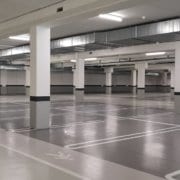The Impact of Ride-Hailing on CRE Property Development
Almost two-thirds of parking experts in a 2018 IPI survey cited ride-hailing companies like Uber and Lyft as having the greatest impact on the parking outlook over other factors and technologies. These types of companies impact dozens of markets, and commercial real estate is no exception. In recent years, “Uber” has become a verb, changing the way people think and talk about transportation and mobility, but what is the market impact of these exploding ride-hailing technologies and how are they changing the game? Read ahead to find out!
What’s the Big Deal About Parking?
Parking is a prime consideration in urban development. Retail, office, and residential buildings are having increasing difficulty estimating need and planning for a future with fewer drivers. This uncertainty can be costly. Developers pay up to $30,000 per space to build structured parking, so overestimating the necessary number of spaces can be extremely costly and limit ROI.
Understanding the trends in parking enables developers to make informed decisions about land allotment in new development. Otherwise, there is a chance you will wind up underutilizing square footage or not providing enough parking for tenants.
So, Why is There Uncertainty?
There are several scenarios in which people are increasingly more likely to ride-hail than to drive a personal vehicle. These include but are not limited to situations such as business trips or personal travel, activities involving alcohol consumption, inclement weather, or even a reluctance to place wear and tear on personal vehicles. And many people these days are choosing to forego ownership of a personal vehicle altogether. The cost to maintain and insure a vehicle rivals the cost of daily ride-hailing, so for those only traveling short distances the benefits can outweigh the costs.
However, the prevalence of ride-sharing can hurt some industries. Airports in particular are struggling to compete with ride-sharing apps because many people don’t want to leave their cars in a public area or don’t want to be charged for parking when there are other options. In response, airports are offering incentives such as parking loyalty programs to keep frequent travelers opting to park instead of ride. Other asset classes feeling the impact include multifamily, office, and retail , with tenants increasingly opting to call an Uber, walk, or bike to work and entertainment. Both Millennials and Baby Boomers are interested in walkability and access to transit when searching for housing, and ride-hailing expands the limited circle in which these potential tenants can take up residence and still live a lifestyle that is personal vehicle-free.
What’s the Outlook?
If you are developing in a Tier I market, the popularity of ride-hailing tech is great news. Parking is less of a consideration in these markets. As a result, required parking allotment will likely decrease from the standard one to two spaces per unit, reducing development costs and allowing for more optimized utilization of square footage.
Hiring a parking professional is a best practice for commercial development, but these experts are quickly evolving into ”transportation experts” as the industry becomes more mobility-focused. These professionals understand the outlook in your particular market, know of any applicable zoning requirements, and can help you plan for the future.
And in the case of construction that already stands, repurposing existing parking structures is one way to profit from the ride-hailing dilemma. Parking spaces currently take up 25,000 square miles in the US, and parking garages can make up thirteen percent of structures in heavily populated, urban areas. Repurposing parking structures for occupancy can be profitable, particularly if some of the existing parking can be preserved. As archaic zoning laws slowly catch on to the changing parking landscape, expect to see more flexibility and opportunity in this area.
Whatever asset class you are working with, ride-hailing technologies are impacting your bottom line. All asset classes require tenants, and tenants require transportation. Stay aware of evolving transportation trends to make smart choices that accommodate tenants and increase ROI.
To learn more about trends causing CRE market disruptions, check out: The Hospitality Industry is Fighting Back Against the Short-Term Rental Disruptors.








